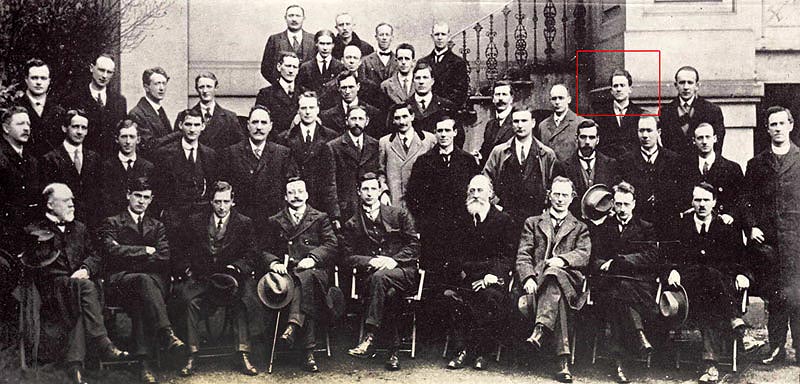Monday night, 7th December 2015 – Lecture by Seán Hogan – “Seamus Burke – Tipperary TD, 1918 – 1938”
Seán Hogan, author of best-selling book “The Black and Tans in North Tipperary” will be the welcome guest speaker at Borrisoleigh Historical Society’s lecture on Monday night next, December 7th 2015. His lecture will feature the life of a neglected figure from recent Tipperary history and a man with deep Borrisoleigh connections. Séamus Burke (1893 – 1967) was a TD for Tipperary from 1918 to 1938. The elements of privilege, tragedy, loss, achievement, celebrity and controversy will be found in Hogan’s telling of the story of Burke’s life.
Lovers of history here in Thurles will be particularly interested in travelling to this lecture. Back in March 1919 it was reported that the tone of speeches made by Séamus Burke; a recently elected Sinn Féin members of Parliament, showed increasing hostility towards the Royal Irish Constabulary (RIC). One such speech was indeed given by the same Seamus Bourke, asserted that the correct way to deal with RIC officers was not to shoot them, as this was being irresponsible, “but (instead) to make their life unbearable, treat them as outcasts of society, as we cannot be in any place that some of these ‘vipers‘ are not in our midst.”
Séamus Bourke was duly prosecuted by the RIC for these apparent inflammatory remarks. His arresting officer was none other than District Inspector Michael Hunt from Thurles, who was later shot dead by first cousins Jim and Tommy Stapleton from Finnahy, Upperchurch and Jim Murphy (Latter known as “The Jennett”) from Curreeney, Kilcommon, on June 23rd 1919, as the former entered Liberty Square. The RIC County Inspector believed then that his involvement with the case against Séamus Bourke was the main reason why District Inspector Hunt had been targeted for assassination.
Séamus Aloysius Burke – Sinn Féin Teachta Dála, Irish Cumann na nGaedheal founder member and later Fine Gael politician.
Séamus Burke’s parents were originally from Borrisoleigh and his family gained a considerable fortune in America, enabling them to live amongst the existing social elite. His early life was blighted by the deaths, from ‘Scarlatina’ (Scarlet Fever), of his two elder brothers. Séamus (James) went on to be educated by the Jesuits in both Fordham College, New York and Clongowes Wood; qualifying as a barrister in 1916.
Seamus A. Burke (Identified by red frame in picture of 1st First Dáil – January 21st 1919,), standing beside school friend Kevin O’Higgins, (on his right), latter who was assassinated on Sunday July 10th 1927 in revenge for his part in the executions of IRA men during the civil war.
Burke’s story encompasses a critical period in Irish politics, in which he was a significant player on the national scene. On December 14th 1918, at the age of 25, he was returned as Sinn Féin Teachta Dála (TD) for mid-Tipperary. One of his roles during the turbulent years of the War of Independence was raising funds in America for the underground Irish Republican movement. However, he was the only Tipperary TD to support the Treaty in 1922 and during the Civil War which followed, his home at Rockforest House was burned after Anti-Treaty IRA men; Frederick Burke (Ileigh), Martin O’Shea (Borrisoleigh), Pat Russell (Thurles) and Patrick McNamara, (Ballina), were executed in Roscrea on January 15th 1923.
Burke headed the poll in Tipperary in subsequent elections and became Minister for Local Government and Public Health in W.T. Cosgrave’s Government of 1923 – 27. His was a very significant contribution to the development of the new State during difficult years, going on to become a founder-member of Cumann na nGaedheal. Although largely absent in the standard texts of the period, Burke’s political contribution was of the same order as his well-known Ministerial colleague and school friend from Clongowes, Kevin O’Higgins, who would be assassinated in 1927.
Burke’s married in 1929; his wife none other than Zenaide Bashkiroff, further adds to the intrigue surrounding his life and times. Zenaide was the niece of Prince Felix Youssopoff, who assassinated Grigori Rasputin, the Russian peasant, faith healer, advisor and trusted friend of the family of Nicholas II, the last Tsar of Russia. Zenaide supported Séamus Burke well in his political endeavours, writing a memoir of their lives entitled “Views from a Window.” (Note if anyone has a copy I would love to read it.) During the 1930’s he was active in debates about the merits of Fascism and Communism in Europe. He was a trenchant critic of Eamonn De Valera and eventually lost his seat in 1938. He retired from politics after narrowly failing to take the last seat in the 1943 election. He later moved to England where he died in 1967.
In his meticulous style as a Tipperary historian, Seán Hogan has now researched extensively on matters relating to Burke’s life. He is a public servant in the Department of Environment, which is the successor in title to the one in which Burke laboured to create for the new State in the very challenging 1920’s, impacting in many ways on the future lives of Irish citizens.
This well-illustrated lecture promises to be yet another memorable event for Borrisoleigh Historical Society; in the societies endeavours to promote Tipperary history.


Leave a Reply